#nbgq
Text
Genderqueer Gay Man Pride Flag
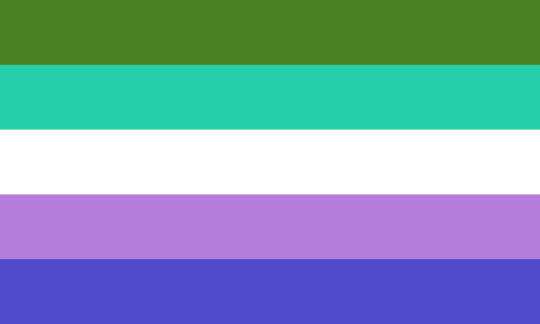
Gay: experiencing homo attraction; umbrella term for those attracted to the same gender or similar genders (alike their own); homo-/simul-/simili-.
Genderqueer: an umbrella term for non-normative genders and non-cis identities; someone whose gender identity does not correspond to conventional binary notions of gender.
#gay male#gayman#gay men#genderqueer man#nbgq#gqnb#gq#genderqueer#gay#mogai#liom#flag combo#mod ap#gender-queer#pride flags#veldian#cinthean#turian#floric#uranian#mlm
63 notes
·
View notes
Text
So, I’ve been thinking about that “There’s nothing straight about a man’s attraction to nonbinary people!” post that was going around a lot a few weeks ago. I know I talked to a mutual or two about why it bugs me. Here’s a better, longer explanation.
Any time we talk about identity, we have to remember two major things. 1. Every identity descriptor has leeway in it. No one person’s experiences and perspectives and feelings perfectly mirror another’s -- we group ourselves together under words we created by going “hey that’s close enough, I feel community with you.” And that’s good. and 2. People have the right to describe their own identities, with the language they know and take comfort in, rather than have any descriptor thrust upon them (or even assumed) by another person.
So, those shouldn’t be controversial statements. I’ve seen them pop up a lot recently in “they/them lesbian” and “bi means more than two” and “are aces/aros really just cis/hets” and “queer isn’t a community word” discourse. Most people recognize that others are allowed to define their own identities with language they find comfortable, and those identities’ labels may not have very distinct lines. Whatever side you’re on in each of these (though I’m rather opinionated and believe there’s a clearly correct side, ngl), you should recognize people’s right to autonomy, and you should recognize that your experiences and perspectives are not universal.
So let’s go back to that post. “There’s nothing straight about a man’s attraction to nonbinary people.” Give straight people the same grace you give LG people, especially when it comes to t/nb/gq identities, where cis people often universally suck. If you acknowledge that a lesbian can happily date a feminine nonbinary person, if you acknowledge that a gay man can happily date a genderfluid person, you should be able to acknowledge that a straight man can happily date a feminine genderqueer person. There’s nothing more inherently nb-inclusive about a lesbian identity or a gay identity than a straight one. Absolutely nothing.
The last, most important thing to note, is that you don’t have a right to pry. You don’t have a right to demand nb/gq people explain why they’re willing to date someone whose identity doesn’t, on the surface, include nb/gq people. You don’t have a right to assume the (potential) partner in question is misgendering the nb/gq person. You don’t get to ask why the (potential) partner is more comfortable calling themself lesbian/gay/straight than bi/pan/mspec. The people in this relationship have already had this discussion, without you, both within themselves before dating anyone, and between each other (if and likely before they begin to date).
People who choose to ID as lesbian can be attracted to nb/gq people. People who choose to ID as gay can be attracted to nb/gq people. People who choose to ID as straight can be attracted to nb/gq people. This invalidates neither person’s identity or orientation.
#straight discourse#queer discourse#nb discourse#dont get me wrong here i understand why nb people might be uncomfortable dating someone whose orientation isnt explicitly inclusive of them#but like lets also acknowledge that there is no nb look#right#like nbgq people rarely get read as nbgq#if somebody found your appearance and personality attractive do you expect them to reevaluate their attraction and id because youre nbgq#thats a lot to ask tbh#let people live#let people self identify#like goddamn if somebodys attracted to pretty much only women#and is respectful of nbgq identities#and finds an nbgq person whos feminine or woman-ish in a way they find attractive#who the fuck are you to tell them they have to reinvent their ID before acting on that attraction#who the fuck are you to define someone elses orientation for them#thats none of your business#thats not how this works#just treat people with respect you fucking demons#my own post wow
10 notes
·
View notes
Photo

Cause we all know Yuri Lowell is the sass master and would deffs say this 😂😂 credit to blastiax @blastiax on tumbler for the idea. #art #painting #gouache #gouachepainting #fanart #fanpainting #meme #yurilowell #talesofvesperia #vesperia #vesperiafanart #vesperiaart #okboomer #sassyyuri https://www.instagram.com/p/CAYPQC-nbgQ/?igshid=kzfvnj065cw https://blastiax.tumblr.com/post/188839024891/what-do-you-mean-thats-not-how-it-went this is the art they did that I was like I have to paint this
#art#painting#gouache#gouachepainting#fanart#fanpainting#meme#yurilowell#talesofvesperia#vesperia#vesperiafanart#vesperiaart#okboomer#sassyyuri#my art
1 note
·
View note
Photo

#الكويت_واحة_العمل_الانساني . . #الامم_المتحدة UN تختار 5 سبتمبر من كل عام #اليوم_الدولي_للعمل_الخيري 🌾 . . . ونحن في *#الكويت* نرشح #محمد_الحصينان @Q8Pinq للحصول على #وشاح_الكويت_للبصمة_الانسانية 🇰🇼 https://www.instagram.com/p/BnXiGq-nBGQ/?utm_source=ig_tumblr_share&igshid=1m3norouez5am
#الكويت_واحة_العمل_الانساني#الامم_المتحدة#اليوم_الدولي_للعمل_الخيري#الكويت#محمد_الحصينان#وشاح_الكويت_للبصمة_الانسانية
1 note
·
View note
Photo
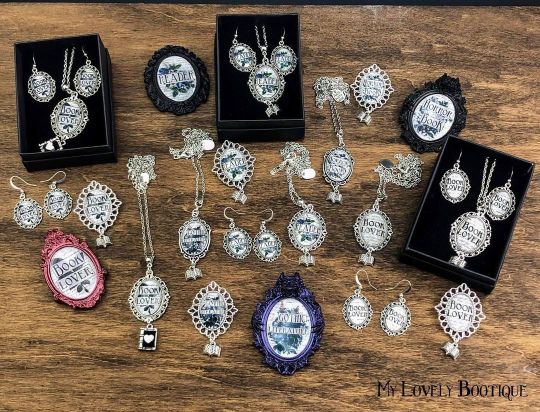
Goodnight book lovers 🖤 are you gonna read something, tonight?! (Necklaces, earrings, brooches and matching sets, all handmade by me, DM for infos) https://www.instagram.com/p/CNDmFy-nbgq/?igshid=185qeuoieeyv7
0 notes
Photo
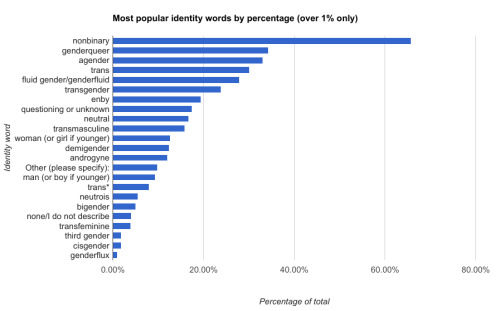
Most Popular Identity Words by Percentage
Source: @gendercensus. "Gender Census," NB/GQ Survey 2017 - the worldwide results (http://gendercensus.com/post/160656902130/nbgq-survey-2017-the-worldwide-results)
10 notes
·
View notes
Text
NBGQ 2017 - the UK TL;DR
Who? Everyone in the UK whose gender doesn’t tidily fit into the female/male binary.
What? An online survey asking UK participants how they describe themselves and how they would like other people to refer to them.
When? February to May 2017.
Participants: 1,357
The full report: click here
Raw data and summary tables: Excel spreadsheet download (7.5 MB)
~
Q1: Identity words
Top 5:
nonbinary - 65%
genderqueer - 34%
trans - 32%
agender - 28%
fluid gender/genderfluid - 27%

~
Q2: Titles
Top 5:
Mx - 38%
No title at all - 27%
Non-gendered professional or academic (eg: Dr) - 13%
Mr - 6%
Miss - 4%

~
Q3: Pronouns
Top 5:
Singular they/them - 78%
He/him - 30%
She/her - 28%
Mix it up - 12%
None/avoid pronouns - 10%

~
Say thanks / Mailing list for next year’s survey / Join a nice inclusive social network
152 notes
·
View notes
Link
0 notes
Link
érdekes statisztikák a legutóbbi nemzetközi (anglofón) éves nem-bináris felmérésből
2 notes
·
View notes
Link
via scientific nutrition - Google News
0 notes
Text
NB/GQ Survey 2017 - the UK results
This report is very long! Click here for the TL;DR. Click here for a printable Google Doc.
~
Well, it’s been a wild year. Three times as many participants as usual, combined with new survey software and new spreadsheet software and health and financial difficulties, has caused some epic delay, plus a few more months of delay for the UK report - but we made it.
The survey ran from 6th February until 1st May 2017 (84 days), with 9,932 participants, of which 1,357 were in the UK. It was promoted on social networks, wherever participants were willing to share. People were invited to take part if they were not fully included in the binary of "anyone whose gender is always entirely and solely male, and anyone whose gender is always entirely and solely female.” It asked:
Which words from a list (plus a textbox) participants identified with [optional, checkboxes];
Which title from a list (plus a textbox) participants most wanted to use [optional, single answer only];
Which pronouns from a list (plus a textbox) participants were happy with [optional, checkboxes];
Whether the participant is in the UK [required];
Age [required];
How you found out about this survey [optional, checkboxes];
The spelling of nonbinary/non-binary/non binary [optional, checkboxes].
A couple more questions were asked, the results of which I’ll not review in this report - I’ll go into more detail later.
[ LINK TO EXCEL SPREADSHEET OF RESULTS HERE ]
~
Question 1: Which of the following best describe(s) in English how you think of yourself?
The top five responses were:
nonbinary - 64.5% (down 2.9%)
genderqueer - 33.7% (down 6.5%)
trans - 32.2% (down 3.9%)
agender - 27.6% (up 0.2%)
fluid gender/genderfluid - 27.3% 29.8 (down 2.5%)
Here’s the graph of identity words that got over 1%:
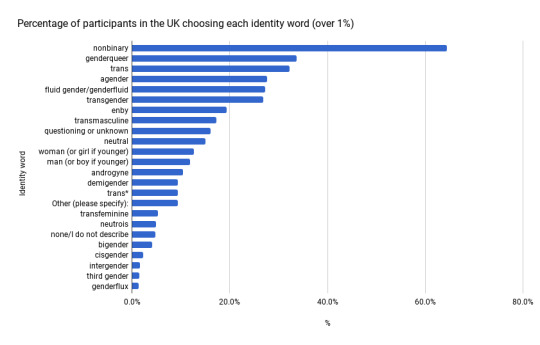
One identity word that wasn’t offered as a checkbox option made it over 1% this year both in the UK and worldwide, and will therefore be offered as a checkbox option next year: genderflux. That’s when one’s gender fluctuates in intensity without necessarily changing. (Not to be confused with genderfluid, when one’s gender changes.)
I will also be adding “binary” to the list next year - because I list cisgender alongside transgender, so it follows that I should list binary alongside nonbinary.
Some numbers I enjoyed:
23 identity words were offered in the survey.
23 identity words were typed into the “other” box more than once, and 60 identity words were typed into the “other” box only once.
That’s 106 identity words total.
People chose on average 3.7 identity words each - around the same as last year.
The most common number of identity words chosen was one - 21% of participants chose one identity label, around the same as last year.
93% of people chose between 1 and 7 identity labels - a little higher than last year.
The worldwide report looks into the shifting popularity of the top ten words for both identity and pronouns, if you’re into that sort of thing.
A note on bias
It’s been bugging me for a couple of years that the survey is probably biased. I’ve been calling it variously the “nonbinary survey”, the “nonbinary/genderqueer survey”, etc. just because those terms are the most popular and I wanted to attract as many participants as possible. Unfortunately, this means that folks who identify as these things are more likely to opt in and take the survey, and people who don’t identify as these things are less likely to realise it’s aimed at them.
I wanted to try to change things this year, but the best I could manage was changing the title to NBGQ. I couldn’t think of a title that wasn’t long and rambling, like “the survey for people whose genders are not tidily described by the binary of ‘always entirely and wholly male’ and etc etc etc.” I suspect that the small change I made didn’t make much difference, so I will keep trying to find a better name.
~
Question 2: In a magical world where all title fields on forms were optional and write-your-own, what would you want yours to be in English?
This question allowed only one answer, though people very occasionally sneakily used the text box to tell me about either-or situations - and those titles were counted too.
The top 5 were:
Mx - 37.6% (down 3.7%)
No title at all - 27.2% (down 6.4%)
Non-gendered professional or academic (eg: Dr) - 12.5% (up 3.6%)
Mr - 5.8% (up 2.9%)
Miss - 4.2% (up 1.8%)
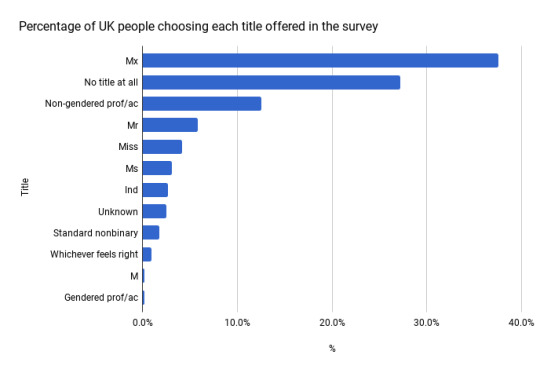
(M was not offered as a checkbox option in the survey, but I’ve included it in this graph because it got more than “gendered professional or academic title”, which was offered in the survey.)
Mx and “no title” have swapped places each year since they were both included in the survey, so the fact that they’ve done so this year is not very notable.
This year I was able to include a text box to allow people who selected “a standard title that indicates my nonbinary/genderqueer identity” to write in what they use to do so. Of the 25 people who chose that option, 60% left that box blank. Each suggested title was entered only once.
A change I would like to make next year is to specify that participants should be currently entitled to use the title they choose. A lot of people choose “non-gendered professional or academic title” and then say “I’m going to get a doctorate so that I can use Dr”. There’s also often a smattering of people who enter military titles and nobility titles. People might be writing these in thanks to the “in an ideal world” tone of the question! So I would like to make the question more clear and specific to reduce that confusion.
~
Question 3: Supposing all pronouns were accepted by everyone without question and were easy to learn, which pronouns are you happy for people to use for you?
The top 5 are the same as last year:
Singular they/them - 78.4% (down 0.4%)
He/him - 29.8% (up 7.8%)
She/her - 27.9% (up 3.9%)
Mix it up - 11.9% (down 0.8%)
None/avoid pronouns - 10.3% (up 0.4%)
9% of people didn’t select any of he, she or they - exactly the same as the international results.
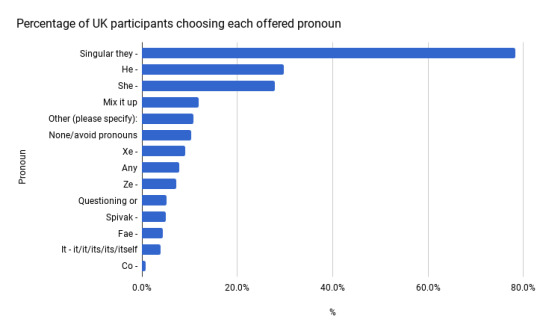
More numbers:
9 specific pronouns were offered in the survey, along with 4 descriptions (for example, “none/avoid pronouns”).
13 pronouns were typed into the “other” box more than once.
44 pronouns were typed into the “other” box only once.
That’s 71 pronouns total.
People chose on average 2 acceptable pronouns each, the same as last year.
Most people (44%) chose only one pronoun.
About 72% of people were happy with only one or two pronouns.
The main change for this question is that last year I tried to combine the numbers for pronouns that were clearly intended to all be the same set, but with almost 10,000 participants that was just not possible. This year, the following hypothetical examples would have each been counted individually:
xe/xem
xe xem xirs
xe/xem/xirself
...etc. There were 28 totally unique write-in entries worldwide for pronoun sets beginning with “ne”, and 26 for “ze” - many of them entered more than once.
Next year I am determined to collect information on each of the five forms of neopronouns, even if that means a participant has to fill out a five question section for each neopronoun they’ve claimed for themself. Ideally I would like to somehow create a form that will do this elegantly, but I know already that I can do it clumsily using Google Forms, so we’ll see. It’s important to me to count the more popular neopronouns accurately.
Notably, the “co” pronoun set was a checkbox option that got under 1% this year, and so it won’t be included as a checkbox option next year.
The worldwide report looks into the shifting popularity of the top ten words for both identity and pronouns, if you’re into that sort of thing.
~
The extra questions
There is more detailed investigation of the statistics regarding age and referring sites over in the worldwide report. For this report I’ll just show how the UK compared to the worldwide statistics:
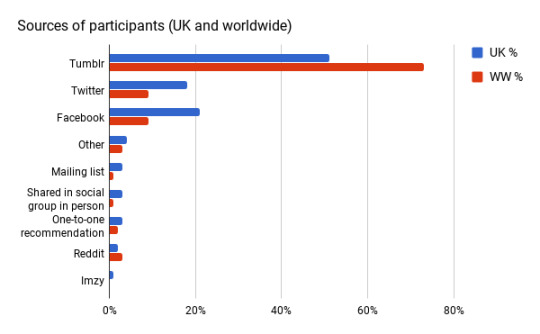
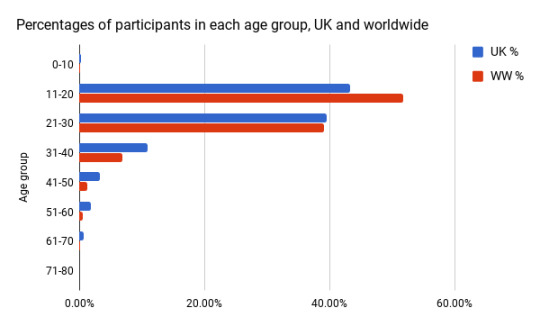
UK people were more likely to find the survey via Facebook or Twitter and less likely to find it via Tumblr. Participants from the UK were also less likely to be teens and more likely to be over 30.
Again, I’ve given an overview of the results of the questions about the spelling of “nonbinary” and umbrella terms over on the worldwide report. I don’t feel that extracting the UK-only results would be very helpful; instead I’ll work on removing bias as much as possible in future surveys.
~
The questions I ask
What should the third gender option on forms be called? - Still no consensus in that area. I won’t feel comfortable recommending the most popular (nonbinary) until I’ve done more work to remove bias in future surveys.
Is there a standard neutral title yet? - Not yet. Mx is looking very promising, and is consistently far more popular than all other titles, but just as many nonbinary people want no title at all. It’s really important that activists campaigning for greater acceptance of gender diversity remember to fight for titles to be optional, too.
Is there a pronoun that every nonbinary person is happy with? - As in previous years, no. The closest we have to a standard is singular they, and so I will use the data to campaign for journalists and anyone else with a style guide to allow it. But around 1 in 5 (20%) of us are not happy with singular they, and 9% of us don’t like he, she or they pronouns.
Are any of the neopronouns gaining ground in a way that competes with singular they? - No. This year the closest is “Xe - xe/xem/xyr/xyrs/xemself” (9% in the UK compared to singular they’s 78%). Users of these neopronouns will probably not reach consensus for many years - language and especially pronouns can be very slow to settle and gain ground. Even if one neopronoun does become very commonly used, many will continue to use other neopronouns for a long time to come.
~
This year in review
There have been a lot of big changes.
We tripled participation! We went from consistently ~2,000-3,000 participants worldwide to TEN THOUSAND. This still boggles me. I feel a little bit overwhelmed that you all trust me with personal information about yourself, and I am excited and honoured every year to play with all the delicious data. From a happily hyperfocused human to 9,932 participants, thank you. <3
The survey now has its own social media presence! Which means people can follow me without having to put up with wittering about the survey, and people can follow the survey without having to put up with me wittering about... well, everything else. It probably helped the survey look more legit, which may in turn explain the increase in participation.
I crowdfunded to cover costs! Originally this was just going to be the survey service, but then it ended up covering MS Excel as well. This process was fraught with hiccups and bad decisions, which is probably not surprising since I’ve never done this before. We reached the £330 target in only a few days, which was wonderful, and it helped a lot.
I used a paid survey software service! Specifically, SmartSurvey. I would recommend it. They had a pay-monthly tier, which allowed me to subscribe to that with the crowdfund money and buy MS Excel in an emergency fashion to process the results when Google Sheets couldn’t handle 9,000+ responses, the wuss. SmartSurvey processed checkbox answers more helpfully, allowing me to process write-ins more easily, among many other lovely features. It wasn’t perfect, but it was a big improvement.
I used MS Excel to process the results for the first time! This was not as much fun as Google Sheets. I had to learn a whole bunch of new techniques to count everything, and some of them didn’t even have Excel equivalents at all. It is also hella buggy and crashy on Mac. Overall, it’s pretty much been a nightmare.
The results are therefore available as a MS Excel file instead of a Google Sheet this year. I am sad about this, because it’s less accessible in a lot of ways. Not everyone has access to Excel! Folks are of course welcome to download the files and mess about with the data however they want.
In a more general sense, academics have approached me with questions about the results, even occasionally asking me for advice or telling me that they will be mentioning the survey in their [academic writings]. One person even sent me a French academic paper they’d found that referenced the 2016 survey, which was fun! I do think that anyone with relevant knowledge can probably see that my work is amateur and flawed, but nonetheless I still think it can be useful - and my experience this year is that it has been useful.
Also in a more general sense, companies and organisations are clearly using the results of the survey to become nonbinary-inclusive. For example, HSBC introduced 10 new titles for nonbinary people this year and a fair few of them are popular among participants of the 2016 survey. Similarly, Bristol Water “did some research and found that [Mx, Ind and Misc] were the most popular” - they don’t refer to the survey directly but those three titles were the three most popular in the 2016 survey. I feel that the results of this survey are making it easier for companies who want to be inclusive to make changes, because let’s be honest, if it’s a choice between ignoring nonbinary people and doing expensive specialist research they’re going to ignore nonbinary people...
What I’ll do differently next year
I will probably change the name of the survey and the associated social media URLs. This will be very disruptive, but I think it will improve the reliability of future survey results by reducing bias.
I will continue to look for better survey and statistics software. Specifically, I want to ask about neopronouns in a better way, and I want software that can handle 10,000+ responses.
Closing thoughts
You are all awesome. I love that you are all willing to trust me with this stuff, and I feel very lucky to be able to do this whole thing because I find it really fun and interesting. I learn so much every time. Thanks for another great survey experience!
See also
A list of links to all results, including UK and worldwide, and including previous years
The mailing list for being notified of next year’s survey
~
SUPPORT ME!
First of all, I do this basically for free (the crowdfunded money went entirely on survey software and MS Excel), so if you happened to stumble onto my Amazon wishlist and accidentally fall on an Add To Cart button... well, I would be immensely grateful. ;)
Second, my girlfriend Andréa and I got really fed up of online dating and social network sites that were not fully inclusive of nonbinary and trans people. Either they don’t offer gender options for us, or they don’t include us properly in searches, or they force us into particular pronoun sets, or we are relegated to an “other” box, or all of the above. So we set about designing Starfriends.org (it was mostly Andréa), which uses a pretty revolutionary tagging system to match you with people based on all kinds of diverse stuff which can include gender if you want, and quite frankly the pronoun system is just VERY EXCITING, I’ve never seen anything like it on any other site. It’s pretty quiet and still in alpha (so it’s a little bit buggy and not fully fleshed out yet), but if this sounds like something you might be into, you’d be very welcome there. :)
39 notes
·
View notes
Text
NBGQ 2017 - the worldwide TL;DR
Who? Everyone whose gender doesn’t tidily fit into the female/male binary.
What? An online survey asking participants how they describe themselves and how they would like other people to refer to them.
When? February to May 2017.
Participants: 9,932
The full report: click here
Raw data and summary tables: Excel spreadsheet download (58.8 MB)
~
Q1: Identity words
Top 5:
nonbinary - 66%
genderqueer - 34%
agender - 33%
trans - 30%
fluid gender/genderfluid - 30%

~
Q2: Titles
Top 5:
No title at all - 31%
Mx - 30%
Non-gendered professional or academic (eg: Dr) - 16%
Mr - 5%
Unknown - 4%

~
Q3: Pronouns
Top 5:
Singular they/them - 81%
She/her - 29%
He/him - 28%
Mix it up - 14%
None/avoid pronouns - 11%
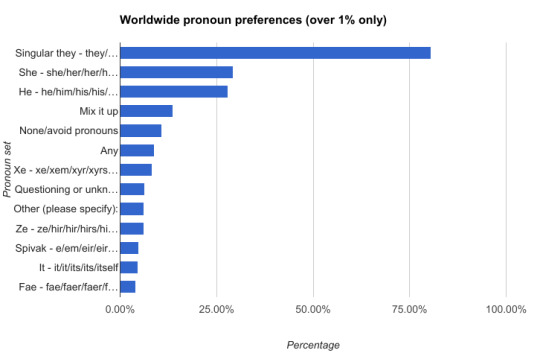
~
Say thanks / Mailing list for next year’s survey / Join a nice inclusive social network
289 notes
·
View notes
Text
NB/GQ Survey 2017 - the worldwide results
This report is very long! Click here for the TL;DR. Click here for a printable Google Doc.
~
Well, it’s been a wild year. Three times as many participants as usual, combined with new survey software and new spreadsheet software and health and financial difficulties, has caused some epic delay - but we made it.
The survey ran from 6th February until 1st May 2017 (84 days), with 9,932 participants. It was promoted on social networks, wherever participants were willing to share. People were invited to take part if they were not fully included in the binary of "anyone whose gender is always entirely and solely male, and anyone whose gender is always entirely and solely female.” It asked:
Which words from a list (plus a textbox) participants identified with [optional, checkboxes];
Which title from a list (plus a textbox) participants most wanted to use [optional, single answer only];
Which pronouns from a list (plus a textbox) participants were happy with [optional, checkboxes];
Whether the participant is in the UK [required];
Age [required];
How you found out about this survey [optional, checkboxes];
The spelling of nonbinary/non-binary/non binary [optional, checkboxes].
A couple more questions were asked, the results of which I’ll not review in this report - I’ll go into more detail later.
[ LINK TO EXCEL SPREADSHEET OF RESULTS HERE ]
~
Question 1: Which of the following best describe(s) in English how you think of yourself?
The top five responses were:
nonbinary - 65.8% (up 1.2%)
genderqueer - 34.3% (down 6.4%)
agender - 33.1% (up 2.2%)
trans - 30.1% (down 4.7%)
fluid gender/genderfluid - 27.9% (down 2.9%)
“Transgender” used to be in the top 5, but dropped by 7% this year. This seems at first glance like a big deal, but it’s hovered between 24% and 31% since the first survey so that kind of fluctuation isn’t unusual.
Here’s the graph of identity words that got over 1%:

One identity word that wasn’t offered as a checkbox option made it over 1% this year, and will therefore be offered as a checkbox option next year: genderflux. That’s when one’s gender fluctuates in intensity without necessarily changing. (Not to be confused with genderfluid, when one’s gender changes.)
I will also be adding “binary” to the list next year - because I list cisgender alongside transgender, so it follows that I should list binary alongside nonbinary.
Some numbers I enjoyed:
22 identity words were offered in the survey.
117 identity words were typed into the “other” box more than once, and 275 identity words were typed into the “other” box only once. That’s one unlisted (under-1%) identity label per 25 people.
That’s 414 identity words total.
People chose on average 3.7 identity words each - around the same as last year.
The most common number of identity words chosen was one - 21% of participants chose one identity label, around the same as last year.
93% of people chose between 1 and 7 identity labels - a little higher than last year.
The following graph shows the data I had available for this year’s top 10 identity words over the past four surveys. Some words don’t have a full history, because they weren’t provided as checkbox options - that’s because write-ins always get much lower numbers. You can see the very scruffy spreadsheet and chart here.
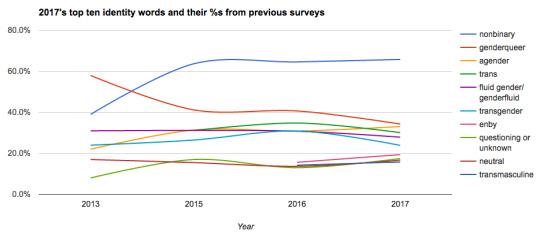
(Note that there is no data for 2014!)
“Nonbinary” is increasing very gradually (up 2% over the past few years), but “genderqueer” seems to be very much a downward trend.
A note on bias
It’s been bugging me for a couple of years that the survey is probably biased. I’ve been calling it variously the “nonbinary survey”, the “nonbinary/genderqueer survey”, etc. just because those terms are the most popular and I wanted to attract as many participants as possible. Unfortunately, this means that folks who identify as these things are more likely to opt in and take the survey, and people who don’t identify as these things are less likely to realise it’s aimed at them.
I wanted to try to change things this year, but the best I could manage was changing the title to NBGQ. I couldn’t think of a title that wasn’t long and rambling, like “the survey for people whose genders are not tidily described by the binary of ‘always entirely and wholly male’ and etc etc etc.” I suspect that the small change I made didn’t make much difference, so I will keep trying to find a better name.
~
Question 2: In a magical world where all title fields on forms were optional and write-your-own, what would you want yours to be in English?
This question allowed only one answer, though people very occasionally sneakily used the text box to tell me about either-or situations - and those titles were counted too.
The top 5 were:
No title at all - 30.8% (down 2.1%)
Mx - 29.6% (down 4.8%)
Non-gendered professional or academic (eg: Dr) - 16.0% (up 3.4%)
Mr - 5.0% (up 2%)
Unknown - 4.4% (up 2%)

Mx and “no title” have swapped places each year since they were both included in the survey, so the fact that they’ve done so this year is not very notable. Unrelatedly, I’m wondering if the “unknown” number being higher than last year is because we had more participants this year, and perhaps more participants spoke English as a second language? (Pure speculation!)
This year I was able to include a text box to allow people who selected “a standard title that indicates my nonbinary/genderqueer identity” to write in what they use to do so. Of the 269 people who chose that option, 72% left that box blank. The most commonly entered title was Mx, by just 10 people. I’ve not looked into this thoroughly, but it looks like the majority of people using Mx are doing so in an inclusive way - meaning anyone can use it regardless of gender identity. The next most popular gender-exclusive title entered was M, by 9 people - which, if implemented in a widespread way, may be mistaken for a first initial or the masculine-gendered French title. Others entered more than once include NB, Msr, Xr and Misc.
A change I would like to make next year is to specify that participants should be currently entitled to use the title they choose. A lot of people choose “non-gendered professional or academic title” and then say “I’m going to get a doctorate so that I can use Dr”. There’s also often a smattering of people who enter military titles and nobility titles.��People might be writing these in thanks to the “in an ideal world” tone of the question! So I would like to make the question more clear and specific to reduce that confusion.
~
Question 3: Supposing all pronouns were accepted by everyone without question and were easy to learn, which pronouns are you happy for people to use for you?
The top 5 are the same as last year:
Singular they/them - 80.5% (up 3%)
She/her - 29.2% (up 4.2%)
He/him - 27.9% (up 4.5%)
Mix it up - 13.6% (up 1.4%)
None/avoid pronouns - 10.7% (down 0.3%)
9% of people didn’t select any of he, she or they.

More numbers:
9 specific pronouns were offered in the survey, along with 4 descriptions (for example, “none/avoid pronouns”).
67 pronouns were typed into the “other” box more than once.
214 pronouns were typed into the “other” box only once.
That’s 295 pronouns total.
People chose on average 2 acceptable pronouns each, the same as last year.
Most people (42%) chose only one pronoun, slightly less than last year.
About 70% of people were happy with only one or two pronouns.
Here’s how the pronouns are faring over time:

The first year had very few options available, so 2015 onward is the most reliable. Singular they keeps increasing, as do binary-gendered (he/him and she/her) pronouns, which have been consistently approximately equal and more acceptable than anything but singular they since I started running the survey.
The main change for this question is that last year I tried to combine the numbers for pronouns that were clearly intended to all be the same set, but with almost 10,000 participants that was just not possible. This year, the following hypothetical examples would have each been counted individually:
xe/xem
xe xem xirs
xe/xem/xirself
...etc. There were 28 totally unique write-in entries for pronoun sets beginning with “ne”, and 26 for “ze” - many of them entered more than once.
Next year I am determined to collect information on each of the five forms of neopronouns, even if that means a participant has to fill out a five question section for each neopronoun they’ve claimed for themself. Ideally I would like to somehow create a form that will do this elegantly, but I know already that I can do it clumsily using Google Forms, so we’ll see. It’s important to me to count the more popular neopronouns accurately.
Notably, the “co” pronoun set was a checkbox option that got under 1% this year, and so it won’t be included as a checkbox option next year.
~
The extra questions
There were a few one-off questions this year. Age, “how did you hear about this survey?”, preferred umbrella terms, and how to spell nonbinary.
I’ll look at the first two questions together, because they really show that this report isn’t representative of the nonbinary population. That’s age and how people were referred to the survey.

For age, around 91% of participants were aged 11 to 30. Assuming that all responses were honest, every age between 10 and 64 was represented, and then some.
There were no limits on how young you could say that you were, so it’s hard to judge how old the youngest participant was - a scattering of people chose ages between 1 and 5, for example. That could be because the question was required, and people just entered a number high on the list, something that was an obvious lie, because they didn’t want to disclose their age. I think that’s fair enough!
Heading in the other direction, we had one definitely-legit participant who was 70 years old.
As for where people came from...

That’s an incredible 73% from Tumblr! Our original promotional post on Tumblr got over 5,800 notes, 3,700 of which were reblogs.
I think it’s fair to say that these ages and referrals are not representative of the nonbinary population. The ages of participants will be influenced heavily by the sites that the survey was promoted on, and even just the fact that the survey is opt-in and hosted only online. Younger people are more likely to be internet-fluent and more likely to be members of communities like Tumblr and Twitter. We also know that younger people are more likely to identify as some kind of not straight, not cis - and we know that the world is becoming more accepting of trans and nonbinary people generally, so younger people are less likely to have experienced discrimination and more likely to feel confident in coming out and seeking community and medical treatment. As such, these statistics should not be considered to be at all representative of the nonbinary population - not just for these two questions but for the entire survey.
I desperately wish that I had the time, money, resources and good health to run a representative survey so that there were any statistics at all about gender-diverse people beyond the binary over the age of 30 and under the age of 16. I’m not aware of any research that sees and counts older and younger nonbinary people and takes into account their language preferences and practical day-to-day needs. If you’re aware of anything, please do send it along to me!
I considered putting in even more work to balance things so that Tumblr users were more fairly represented, to see if it drastically changed any of the other statistics, but in the end I decided not to. This was in part because I had already taken 2 months longer than planned to get the results sorted out, but also partly because... well, a lot of nonbinary people hang out on Tumblr, it’s very very easy to share information here, and that’s where I do most of the promotion - that’s where the Nonbinary Stats blog is hosted. Having said that, almost 3,000 people came from not-Tumblr, which is not to be sneezed at.
Perhaps people from Reddit are more likely to be genderqueer than nonbinary, or Facebook users are less likely to use binary-gendered pronouns, or whatever. But that’s work that I can’t do for this report. I am sure that something interesting can be gleaned from the raw data, so if anyone would like to use it to do the relevant calculations please feel free! Or I might do it myself in a couple of months, if I can. The link to the data download is at the top of this post, just after the introduction.
Next are umbrella terms and the spelling of “nonbinary”. Earlier I mentioned the bias that comes with calling a survey “nonbinary/genderqueer”, and that holds here too.
For the spelling of nonbinary: I spelled nonbinary without a space or a hyphen throughout the survey, including in titles and promotion. So it’s probably not surprising that this was the most popular spelling at 59% - non-binary came second with 33%. But because of that bias, I just don’t think this can be considered a reliable result. (Relatedly, I ran a Twitter poll a few months back that got a similar result with far fewer participants.)
I will ask again in a future survey, once I’ve managed to remove the unnecessary use of the word from the survey and promotional materials.
For the umbrella terms: 57% of participants were in favour of us having an umbrella term. When asked what they thought it should be and provided with a text box, the vast majority chose “nonbinary”, a much smaller proportion chose “genderqueer”, and many people said “I don’t know” or appeared to misunderstand the question, which is probably down to poor question design more than anything else.
I’m considering the results of this question completely unreliable statistically, but I will use them to inform future questions - again, hopefully with reduced bias! (I’ve used nonbinary and genderqueer as umbrella terms pretty much exclusively with this survey, so that will have skewed things a lot.)
~
The questions I ask
What should the third gender option on forms be called? - Still no consensus in that area. I won’t feel comfortable recommending the most popular (nonbinary) until I’ve done more work to remove bias in future surveys.
Is there a standard neutral title yet? - Not yet. Mx is looking very promising, and is consistently far more popular than all other titles, but just as many nonbinary people want no title at all. It’s really important that activists campaigning for greater acceptance of gender diversity remember to fight for titles to be optional, too.
Is there a pronoun that every nonbinary person is happy with? - As in previous years, no. The closest we have to a standard is singular they, and so I will use the data to campaign for journalists and anyone else with a style guide to allow it. But around 1 in 5 (20%) of us are not happy with singular they, and 9% of us don’t like he, she or they pronouns.
Are any of the neopronouns gaining ground in a way that competes with singular they? - No. This year the closest is “Xe - xe/xem/xyr/xyrs/xemself” (8.2% compared to singular they’s 80%). Users of these neopronouns will probably not reach consensus for many years - language and especially pronouns can be very slow to settle and gain ground. Even if one neopronoun does become very commonly used, many will continue to use other neopronouns for a long time to come.
~
This year in review
There have been a lot of big changes.
We tripled participation! We went from consistently ~2,000-3,000 participants to TEN THOUSAND. This still boggles me. I feel a little bit overwhelmed that you all trust me with personal information about yourself, and I am excited and honoured every year to play with all the delicious data. From a happily hyperfocused human to 9,932 participants, thank you. <3
The survey now has its own social media presence! Which means people can follow me without having to put up with wittering about the survey, and people can follow the survey without having to put up with me wittering about... well, everything else. It probably helped the survey look more legit, which may in turn explain the increase in participation.
I crowdfunded to cover costs! Originally this was just going to be the survey service, but then it ended up covering MS Excel as well. This process was fraught with hiccups and bad decisions, which is probably not surprising since I’ve never done this before. We reached the £330 target in only a few days, which was wonderful, and it helped a lot.
I used a paid survey software service! Specifically, SmartSurvey. I would recommend it. They had a pay-monthly tier, which allowed me to subscribe to that with the crowdfund money and buy MS Excel in an emergency fashion to process the results when Google Sheets couldn’t handle 9,000+ responses, the wuss. SmartSurvey processed checkbox answers more helpfully, allowing me to process write-ins more easily, among many other lovely features. It wasn’t perfect, but it was a big improvement.
I used MS Excel to process the results for the first time! This was not as much fun as Google Sheets. I had to learn a whole bunch of new techniques to count everything, and some of them didn’t even have Excel equivalents at all. It is also hella buggy and crashy on Mac. Overall, it’s pretty much been a nightmare.
The results are therefore available as a MS Excel file instead of a Google Sheet this year. I am sad about this, because it’s less accessible in a lot of ways. Not everyone has access to Excel! Folks are of course welcome to download the files and mess about with the data however they want.
In a more general sense, academics have approached me with questions about the results, even occasionally asking me for advice or telling me that they will be mentioning the survey in their [academic writings]. One person even sent me a French academic paper they’d found that referenced the 2016 survey, which was fun! I do think that anyone with relevant knowledge can probably see that my work is amateur and flawed, but nonetheless I still think it can be useful - and my experience this year is that it has been useful.
Also in a more general sense, companies and organisations are clearly using the results of the survey to become nonbinary-inclusive. For example, HSBC introduced 10 new titles for nonbinary people this year and a fair few of them are popular among participants of the 2016 survey. Similarly, Bristol Water “did some research and found that [Mx, Ind and Misc] were the most popular” - they don’t refer to the survey directly but those three titles were the three most popular in the 2016 survey. I feel that the results of this survey are making it easier for companies who want to be inclusive to make changes, because let’s be honest, if it’s a choice between ignoring nonbinary people and doing expensive specialist research they’re going to ignore nonbinary people...
What I’ll do differently next year
I will probably change the name of the survey and the associated social media URLs. This will be very disruptive, but I think it will improve the reliability of future survey results by reducing bias.
I will continue to look for better survey and statistics software. Specifically, I want to ask about neopronouns in a better way, and I want software that can handle 10,000+ responses.
Closing thoughts
You are all awesome. I love that you are all willing to trust me with this stuff, and I feel very lucky to be able to do this whole thing because I find it really fun and interesting. I learn so much every time. Thanks for another great survey experience!
See also
A list of links to all results, including UK and worldwide, and including previous years
The mailing list for being notified of next year’s survey
~
SUPPORT ME!
First of all, I do this basically for free (the crowdfunded money went entirely on survey software and MS Excel), so if you happened to stumble onto my Amazon wishlist and accidentally fall on an Add To Cart button... well, I would be immensely grateful. ;)
Second, my girlfriend Andréa and I got really fed up of online dating and social network sites that were not fully inclusive of nonbinary and trans people. Either they don’t offer gender options for us, or they don’t include us properly in searches, or they force us into particular pronoun sets, or we are relegated to an “other” box, or all of the above. So we set about designing Starfriends.org (it was mostly Andréa), which uses a pretty revolutionary tagging system to match you with people based on all kinds of diverse stuff which can include gender if you want, and quite frankly the pronoun system is just VERY EXCITING, I’ve never seen anything like it on any other site. It’s pretty quiet and still in alpha (so it’s a little bit buggy and not fully fleshed out yet), but if this sounds like something you might be into, you’d be very welcome there. :)
163 notes
·
View notes
Text
NBGQ 2017: 24 hours, and 1,800+ responses
That’s over 1 response per minute for the entire 24 hours.
And almost 100 new followers in that time, too - hi new people!
If you’ve not shared already, please consider doing so. Last year we had 3,055 responses, and I’d love if we could continue the four-year trend and build on that again. Sharing on Tumblr is great, and sharing in other places is even better. :)
To recap, it’s a survey of eight questions, most of which are optional, about the language that you use to describe and express your genders. It’s aimed at anyone who doesn’t feel fully at home in/with the gender binary. And it’s extremely useful for activism, visibility, and generally just knowing more about our community and being respectful and inclusive of all its members.
It closes no sooner than 27th February 2017.
Click here to take part. :) Thank you so much!
111 notes
·
View notes
Text
Crowdfunding: £350 for a SurveyMonkey subscription
Hello!
It’s nearly time to run the annual NBGQ survey for 2017, and I need your help.
I’ve been using Google Forms for three years, because it lets me have as many responses as I can get for free, which seems to be 3,000+. However, Google Forms is quite basic. It has some limitations, and the way it presents your data means results can take a lot of time and energy to process. Collecting and processing pronouns, in particular, is extremely arduous!
It’s time to step it up a notch. I’d like to try using something more fit for purpose. SurveyMonkey will let me have over 1,000 respondents for £300. (The £50 extra in the title covers IndieGoGo fees.) This would mean a lot of really useful tools for me to process the results, and it means I can continue to use the survey software for more smaller surveys throughout the year.
Can you help me? The campaign ends on 3rd March 2017. Any amount however small helps cover this cost, which I just can’t afford on my own.
[TO THE INDIEGOGO CAMPAIGN]
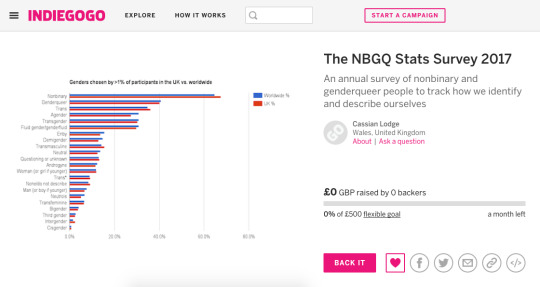
56 notes
·
View notes